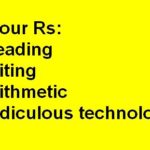Teschler on Topic
Leland Teschler • Executive Editor
[email protected]
On Twitter @ DW_LeeTeschler
Your last encounter with a textbook likely involved simple diagrams, bullet-point lists, and several other constructs designed to condense concepts and present them as simply as possible. It turns out that this dumb-it-down approach isn’t helpful for learning things and, in fact, might make learning more difficult.
Neuroscientists who study learning now say people learn best when they are confused. Moreover, we  are more likely to remember new information picked up in shorter bursts rather than through intensive learning sessions.
are more likely to remember new information picked up in shorter bursts rather than through intensive learning sessions.
Insights on the subject come from UCLA neuroscientists Robert and Elizabeth Bjork who say a counterintuitive technique called productive failure promotes rapid acquisition of knowledge. Here the instructor asks students to solve problems they have no clue how to handle. Only after a lot of wheel-spinning and struggle is the correct method revealed. You’d be right if you suspected that stunts like this in a classroom might result in a bunch of ticked-off students.
But introducing difficulties this way works better than making the learning process easy, the two scientists say. Also unsurprising is that few schools try to make use of such techniques though evidence of their effectiveness is mounting.
A study of British Post Office workers illustrates the benefit of another idea that goes against common beliefs about learning. Workers taught to use letter sorting machines for just one hour daily over a long period got more out of the training than others who received four hours of daily instruction over a briefer interval. Interestingly, workers receiving the briefer training didn’t think much of it; they felt as though they weren’t mastering their tasks. But tests revealed they had picked up the basics 30% faster than the quickest learners among their counterparts who endured longer training sessions.
Researchers say people benefit from learning in smaller chunks because doing so lets them forget some of what they learned in the last session, forcing them to work at relearning it. The process of forgetting and relearning strengthens your long-term recall. Those who spend longer chunks of time drilling don’t get the benefit of the more numerous forget/remember cycles.
It turns out that most U.S. schools don’t like to try ideas that make things difficult for students (and ruffle the feathers of teachers), even if there’s evidence they work.
But that’s not the case in East Asia, says David Robson, author of The Intelligence Trap and a former editor at the magazine New Scientist. Students in countries such as Japan appreciate that struggle is necessary in education, he says. There, even elementary school students are taught to discover new ways of solving problems for themselves and to consider alternative solutions. And they are encouraged to wrestle with problems whose solutions aren’t immediately straightforward. No wonder, then, that East Asian students score better than U.S. students on measures of critical thinking and evidence-based wisdom.
So think back to the days when you stumbled out of your engineering classes confused and discouraged. Little did you know, though it didn’t seem so at the time, your instructors were actually doing you a favor. DW
You may also like:
Filed Under: Commentaries • insights • Technical thinking








